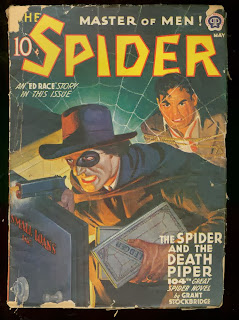 Happy Halloween, readers! While I'd originally intended to mark today by taking a break from The Big Book of Adventure Stories and talking about Robert E. Howard's classic Southern Gothic tale of revenge and undeath, "Pigeons from Hell," I happened to look ahead in The Big Book and was delighted at what I saw was next. I'd originally discovered the works of Saki (real name: H.H. Munro) at least a dozen years ago in a slim book in my grandmother's house; the book included today's story which, like many of Saki's works, satirized his native Edwardian England, with a macabre twist to it all. When I saw that "Sredni Vashtar" would fall on Halloween if I stuck with The Big Book of Adventure Stories, I knew I had to leave Howard aside for the time being and talk about this story. Short, sweet and gruesome, this story (and several of Saki's other tales) can be read for free here.
Happy Halloween, readers! While I'd originally intended to mark today by taking a break from The Big Book of Adventure Stories and talking about Robert E. Howard's classic Southern Gothic tale of revenge and undeath, "Pigeons from Hell," I happened to look ahead in The Big Book and was delighted at what I saw was next. I'd originally discovered the works of Saki (real name: H.H. Munro) at least a dozen years ago in a slim book in my grandmother's house; the book included today's story which, like many of Saki's works, satirized his native Edwardian England, with a macabre twist to it all. When I saw that "Sredni Vashtar" would fall on Halloween if I stuck with The Big Book of Adventure Stories, I knew I had to leave Howard aside for the time being and talk about this story. Short, sweet and gruesome, this story (and several of Saki's other tales) can be read for free here.Conradin is a sickly ten year old boy, and according to the doctors, unlikely to live another six months. He lives in the care of his cousin, Ms. De Ropp, whom he privately refers to simply as "the Woman." Overbearing and distasteful, the Woman's ministrations strike Conradin as cruel, pointless, and likely the cause of his deterioration. For her part, while she would never openly admit to disliking Conradin, she'll admit to feeling no displeasure at depriving him of things that might be "bad" for him.
Conradin has two "friends," both of whom live in a disused gardener's shed at the back of the Woman's property. The first, dubbed Henrietta, is a mature hen; the second is Sredni Vashtar, a "polecat-ferret" kept locked in a hutch, discreetly purchased from the local butcher's boy. In Conradin's lonely mind, Sredni Vashtar assumes the proportions of a diabolic god, and Conradin comes to worship the beast as an idol.
On the grounds that being out in the shed so much can't be good for the boy, the Woman has Henrietta removed and sold; upon noticing that the removal of the hen does not stop Conradin from visiting the shed, she realizes that something is locked in the hutch. Assuming the hutch to contain guinea pigs, the Woman goes to clear them out, as Conradin watches in horror and dejection from the house. But Conradin has been praying to Sredni Vashtar, and perhaps today's the day his prayers are answered...
"Sredni Vashtar," like its eponymous polecat-ferret, is proof of the power that can be contained in small packages. In The Big Book of Adventure Stories, "Sredni Vashtar" clocks in at just three pages but it's a powerful tale that just sticks to you forever, you know?
The story is told entirely from Conradin's perspective, and he seems like a fairly hale and healthy boy (or at least, perceives himself as such), and it's hard to get a sense of him as sickly; I, at least, came away from the story with the nagging idea that Conradin's supposed sickness is an imaginary hobgoblin, created and enforced by the Woman to keep Conradin quiet, contained and inoffensive. The fact that she forbids him the luxury of having toast on the equal grounds of it A) being "bad for him" and B) because it's too much trouble to make, I think lends credence to this idea that his "illness" is something she's created. His satisfaction as he sits in the dining room, defiantly making himself buttered toast, while listening to the maid in the other room debating with the rest of the household staff how to tell him his cousin's run afoul of Sredni Vashtar seems like the medicine he needed all along.
While an iconic and popular tale, I feel like "Sredni Vashtar" lacks some of the twistedness that makes many of Saki's tales so much fun. As soon as you know Conradin has an overbearing guardian and a pet ferret, you know she's going to meet a bad end by said ferret; compare with a story like, say, "The Interlopers," where just as things are starting to look up for the characters, things turn worse then ever.
















